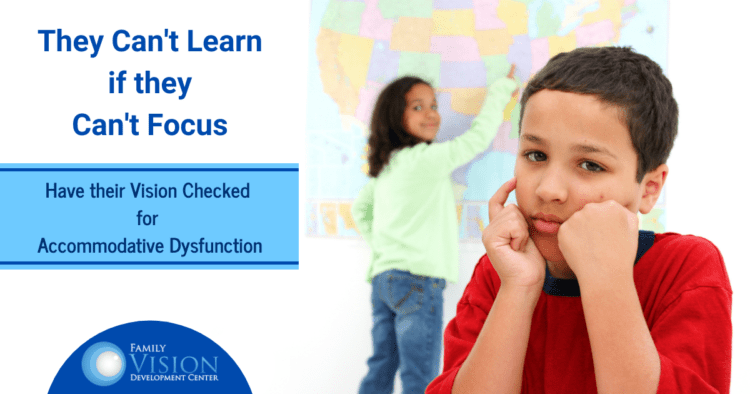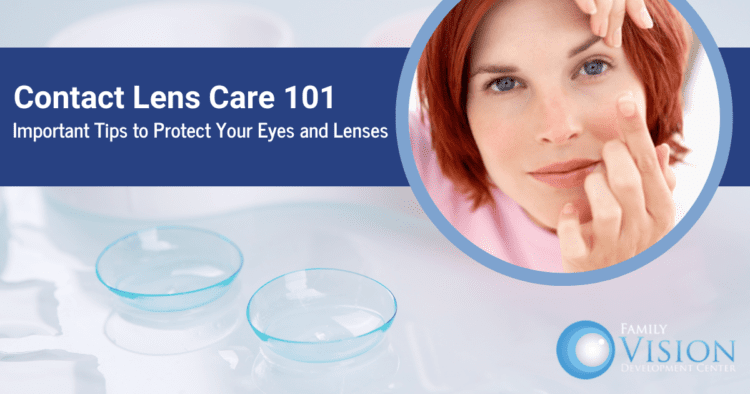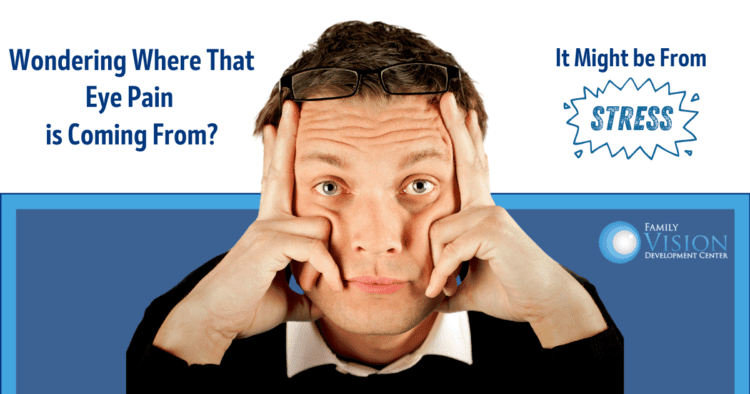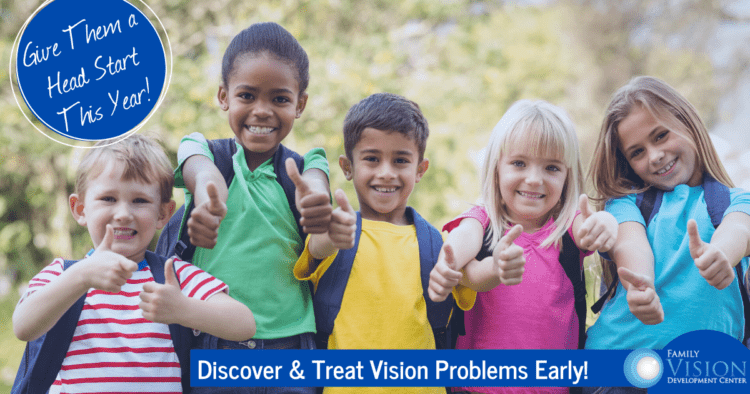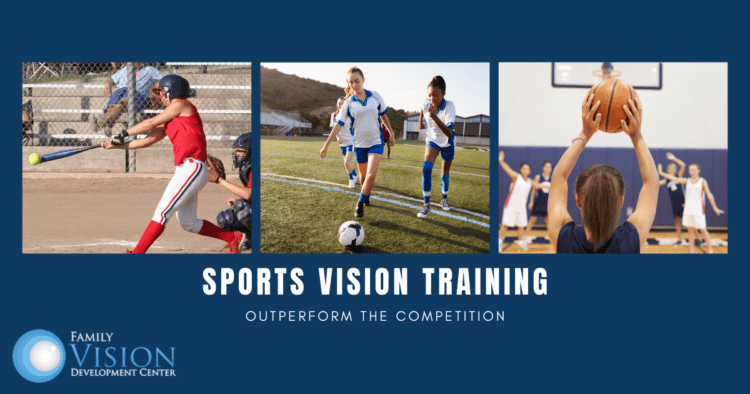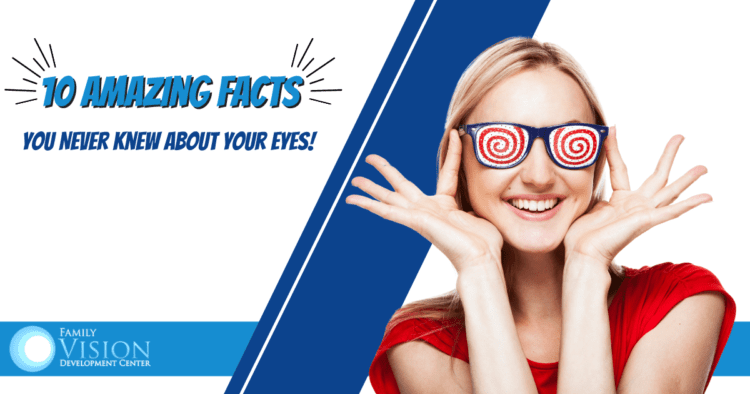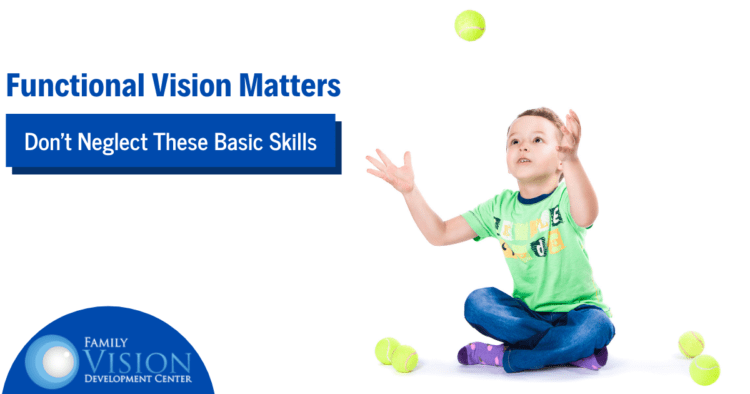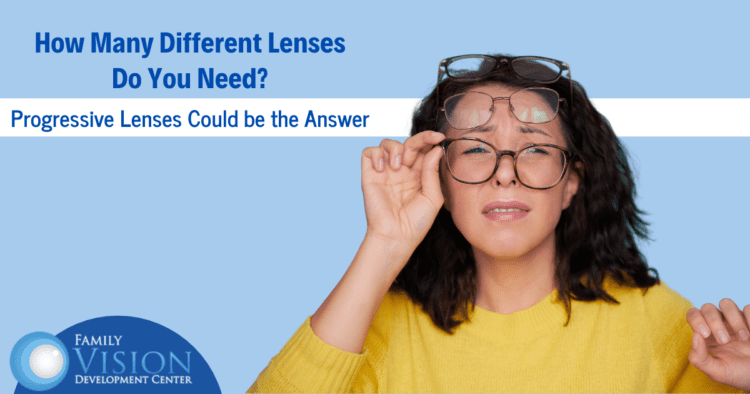Accommodative dysfunction is a complex term for a very common vision disorder in both kids and adults. In short, it means difficulty shifting your focus from near to far. For example, you may be focused on a computer screen and then look across the room, only to find it difficult to regain focus at either distance.
Why Accommodative Dysfunction Should be Corrected
Accommodative dysfunction can be a very frustrating vision disorder and can make daily life difficult for kids and adults, especially in the following situations.
Classroom performance – when a child has trouble focusing at varying distances, it can be hard to achieve success in school. Kids spend much of their school day looking from close objects on their desks to distant objects like the teacher at the front of the room. When this causes blurred vision, it can make classroom activities and learning much more difficult and their grades can suffer because of it.
Participating in sports – many kids are interested in joining their school athletic teams but are limited in their ability due to their focusing problems. Playing a sport well depends on strong visual skills, so it can be very frustrating for kids to lose the opportunity to play simply because of a vision disorder. Additionally, playing a sport, even for fun, can become dangerous if the athlete cannot properly focus on the activity going on around them.
Work performance – Many people have jobs that depend on acute visual ability. Warehouse or assembly line workers depend on their ability to properly focus on their surroundings for safety reasons. And even business professionals need to focus while in meetings and presentations. Accommodative dysfunction is typically diagnosed in kids, but adults should also be aware of the issue and understand that there are treatment options.
Vision Therapy as a Treatment for Accommodative Dysfunction
One very effective form of treatment for accommodative dysfunction is vision therapy. Through a series of specialized eye exercises, this sort of physical therapy for the eyes and brain can retrain your visual system to restore proper focusing. The sessions are short and take place right in our Aurora location.
We are Vision Therapy Specialists
Vision therapy is not a “one size fits all” treatment program. Each program should be individually tailored based on the specific issues to be corrected. At Family Vision Development Center, our doctors have advanced training in a variety of vision therapy techniques, including neuro-optometric vision rehabilitation, syntonic light therapy and more. We perform a thorough vision examination and determine the best course of treatment for each patient, and are committed to providing the best possible care in a safe, comfortable environment. Contact our office at 630-862-2020 to schedule an appointment.
Additional information can be referenced here
If you’ve made the decision to wear contact lenses to correct your vision, you absolutely must care for them properly if you want to avoid issues. In order to keep your eyes healthy, comfortable and injury-free, remember the following helpful tips when caring for your contact lenses.
Personal Care
There are a number of things you can do in terms of personal hygiene and activity that will help keep your contact lenses clean and sanitary, as well as keep your eyes protected from infection or irritation.
- DO – Wash your hands thoroughly with a mild soap and rinse completely before touching the contact lenses
- DON’T – Use any lotions, oils, or cosmetics right before handling the lenses
- DO – Keep your fingernails short and smooth and try to avoid contact between your nails and the lenses
- DON’T – sleep in your contact lenses
- DON’T – share your contact with anyone else
Contact Lens Care
Proper care of contact lenses requires following the specific routine prescribed by your eye care professional. The following tips will ensure the best experience possible:
- DO – Use fresh, unexpired lens solution and carefully follow the specific instructions on the solution bottle
- DON’T – Alternate or mix solutions, as not all solutions are safe for all lenses
- DON’T – Put lenses in your mouth or use saliva to lubricate your lenses
- DON’T – Rinse your lenses in tap water, as the lens could wash down the drain, or the impurities in the water may damage the lenses
- DO – store your contact lenses in an appropriate lens case, and clean the case regularly to avoid bacteria growth
If you ever notice symptoms of redness, itching, burning, eye pain, discomfort or any abnormal changes in your vision it is important to remove the contact lenses and contact your optometrist immediately.
Regular Eye Exams are an Important Part of Wearing Contacts
The professional eye care providers at Family Vision Development Center in Aurora are here to help make your contact lens experience as easy as possible. We offer the latest in contact lens technologies along with a variety of designs, such as daily wear, extended wear and specialty lenses. Call us at 630-862-2020 to schedule your appointment or visit www.fvdcpc.com to learn more about our practice.
Additional information can be referenced here.
Stress levels have been at all-time highs for so many people throughout the past year. Job worries, money concerns, remote learning and more can cause anxiety levels to increase – and that’s not good for anyone. Aside from the possible effects on your heart and blood vessels, muscles, intestines and nervous system, stress can also have an impact on your vision.
How Stress and Vision are Related
Did you know that your eyes and vision are an extension of your brain? There are six muscles connected to each eye, and they receive signals from the brain. These signals direct the eyes movements and, thus, control their ability to focus. When you are stressed, your brain goes through a number of changes and signals some of your body’s glands to release hormones in an attempt to deal with the stressor. With the brain undergoing all of these alterations, the eyes may become impacted as a result of their connection.
Possible Vision Effects
When you experience a stressful moment, adrenaline is pumped through the body at great speeds. This causes the pupils to dilate, which increases the amount of light that enters the eyes. If too much light enters during a moment of anxiety, or if you go through repeated stressful moments and light penetrates the eyes, the following can occur:
- Light sensitivity
- Eye aches and strain
- Blurriness
- Eye twitching
- Eye floaters
- Tunnel vision
- Double vision
- Very dry or very wet eyes
Most stress-related eye issues are minor and temporary. If you find yourself experiencing any of the above issues, try the following:
Closing your eyes
Taking deep breaths and/or meditating
Finding a distraction to take your mind off what is bothering you
Exercising (such as walking or running)
Writing in a journal
Don’t Delay Treatment
Long-term stress or anxiety can actually cause serious strain on your eyes, so it is important to see us if these issues do not resolve themselves quickly. A comprehensive vision exam can help us discover the true cause of the vision problems, as well as allow us to determine the best form of treatment. Additionally, if stress-reduction therapies are necessary, we can work with your medical doctor or other healthcare providers to find the right overall solutions.
At Family Vision Development Center, we take a one-on-one approach to vision care that focuses on whole body wellness that extends beyond the eyes. We are dedicated to providing safe, personalized care to members of the whole family in a welcoming environment. Contact us at 630-862-2020 for all of your eye care needs.
Additional information can be referenced here
When a child has vision problems, it can affect many areas of their daily life, including their learning ability. And it may not be as evident as blurred vision. In fact, a child could have perfectly clear eyesight, but still have vision issues that can prevent them from achieving success in school.
Types of Vision Problems
There are several types of vision problems, all of which can affect your child’s ability to read, write and succeed in the classroom in different ways. The following are some common vision problems in children that may interfere with learning ability.
Children with a refractive error have an irregularly shaped cornea that does not bend light properly. This can cause blurred vision, difficulty reading things up close or a crossing of the eyes. If your child holds a book very close to their eyes or squints when trying to read or see the front of the classroom, they may be suffering from a refractive vision problem.
- Functional Vision Problems
These refer to problems affecting the way that the eyes and brain work together. This can lead to problems in eye teaming (binocularity), accommodation (i.e., the ability of the eye to focus on an object at different distances), hand-eye coordination, peripheral vision or fine eye movements. A child with a functional vision problem may experience double vision, transposing letters, confusing similar words, difficulty with reading, spelling and math, and poor performance in sports.
- Perceptual Vision Problems
Perceptual vision problems are characterized by difficulty understanding and identifying what one sees. A child with poor visual perception may have 20/20 vision, but might have trouble distinguishing between two similar letters (such as u and n), putting a puzzle together or finding a pair of matching socks in a drawer. Other signs of a visual perception disorder could include skipping words or lines when reading, memorization trouble, or understanding a map.
Vision Therapy is an Effective Solution for Kids
One proven treatment for kids with visual concerns like those listed above is vision therapy. This customized treatment plan consists of specialized eye exercises that work to retrain the eyes and brain in order to correct or restore visual ability. At Family Vision Development Center, our providers are trained in a variety of advanced vision therapy techniques, so we can create a program that targets your child’s individual vision issues.
While parents may be quick to assume that their child’s learning ability is determined by their study habits, or even genetics, they may not even think to look at their vision. A comprehensive eye exam at Family Vision Development Center can uncover any vision conditions or disorders that can lead to poor performance in school. Early detection often provides more opportunity for treatment options, so it is recommended that kids get yearly vision exams to quickly discover any signs of a problem. Contact us today at 630-862-2020 to schedule an appointment.
Most people understand the importance of seeing their medical doctor for regular exams in order to maintain their health. But seeing an eye doctor for vision exams on a regular basis is just as important in order to maintain proper eye heath. Here’s what you can do to protect your vision at any age.
Start Early
The old saying about the early bird catching the worm is an accurate one, as many eye conditions are more effectively treated the earlier they are detected. Unfortunately, many children are not getting regular eye exams, instead relying on simple screenings that do not detect many forms of eye disease. For example, Amblyopia, a vision development disorder, can affect 2-3% of all children. If promptly treated, vision loss can be avoided. But if left untreated, it can escalate to the point of legal blindness.
Start Later
Even though the best time to start your visits to the eye doctor is while you are young, it is OK to start later in life. Don’t get the idea that if you did not have eye exams as a child, there is no point going as an adult. It is never too late to start caring for your eyes! There are many treatment options available for adults so don’t hesitate to address any vision concerns as you get older.
Prevent Eye Diseases with Continued Care
As you age, regular eye exams can detect many eye diseases that can cause serious damage if not treated such as:
- Cataracts
- Diabetic retinopathy
- Glaucoma
- Age-related macular degeneration
Many eye diseases start without any symptoms and therefore go unnoticed for long periods of time, making treatment options more difficult in some cases. A comprehensive eye exam is the best way to detect these diseases in their early stages when treatment is most effective for preventing vision loss.
Establish Routine Vision Exams for the Whole Family
The best way to maintain healthy vision is to establish a schedule for exams for each member of the family and stick to it. It is recommended the children get their first exam at 6 months, then at age 3 and again before kindergarten. Eye exams should be performed on an annual basis after age 5 and throughout life. People with diabetes and those with a higher risk for glaucoma should get a dilated eye exam every year.
Regular visits to your optometrist can keep your vision strong throughout your life. Contact Family Vision Development Center in Aurora at 630-862-2020 to schedule an appointment for each of your family members to get started on better eye health.
Adult vision therapy is a type of physical therapy for the eyes and brain, and consists of specialized “eye exercises” that help to recover or develop important visual skills. Typical vision therapy programs are often recognized as a great way to help children correct their vision, improve their reading skills, increase their athletic ability and even feel better about themselves. But the fact is, it can do the same amazing things for adults! It’s never too late for self-improvement. And while glasses or contacts alone may not be the best way to correct your vision, a customized adult vision therapy program just might give you the results you are looking for. Here are a few important ways that vision therapy can make a difference in an adult’s life.
- Improve performance at work – the right adult vision therapy program can improve hand-eye coordination, the ability to read things up close (such a book or computer) and the ability to concentrate. These visual improvements not only improve performance, but can also reduce stress in the workplace and make you a more productive worker.
- Reduce headaches – more than 15% of adults experience severe headaches or migraines. Both of these are common symptoms of a binocular vision problem (a condition in which the eyes don’t align properly). An adult vision therapy program can improve the communication between the eyes and brain, correct the binocular vision disorder and alleviate the headaches.
- Correct eye turns (strabismus) – while commonly experienced by children, adults can also suffer from strabismus, or eye turns. This can present as inward or outward crossing of one or both eyes, and can be consistent or intermittent. Vision therapy is highly effective for improving eye alignment, eye movements, focusing and more.
- Restore vision following a stroke or concussion – a traumatic brain injury (TBI), including a concussion, stroke, sports-related head injury, car accident or other violent blow to the head, can severely impact the visual system. A vision therapy program known as neuro-optometric rehabilitation can help restore visual impairment that has resulted from a TBI.
- Improve overall feeling of well-being – experiencing a vision disorder can have the same effect on an adult as it does on a child. A daily struggle with underdeveloped visual skills can have a big impact on your overall emotional health. Adult vision therapy is a great way to improve overall performance, motivation and self-confidence, which can result in more happiness at home and with your family.
Family Vision doctors are adult vision therapy specialists
Our vision therapy specialists have extensive experience and advanced training in a variety of techniques, including advanced therapy such as vision rehabilitation after traumatic brain injury and syntonic light therapy. We treat patients of all ages, and will customize your treatment plan according to your specific vision correction needs. Contact our Aurora office at 630-862-2020 to learn more or to schedule a consultation with one of our doctors.
Additional information can be referenced here
Most young sports athletes are competitive in nature. In this sense, they want to earn a spot on the best team and play in the most games possible. In order to accomplish these goals, they must have highly developed skills in certain areas and outperform those they are competing against for the limited spots on the team. One effective way for your athlete to prepare is to participate in a sports vision training program. These unique vision therapy programs are specifically tailored to the individual athlete to help develop and strengthen their visual skills and help them gain a competitive edge over their competition.
During a sports vision therapy program, athletes work on enhancing the following skills and abilities:
- Hand-eye coordination – using the eyes to control the movement of the hands
- Visual reaction time – the amount of time it takes to perceive a visual event and react to the stimulus
- Eye tracking – the ability to maintain focus on a specific moving object (keep your eye on the ball!)
- Visual acuity – the ability to see an object clearly while it is in motion
- Eye focusing – the ability to keep an object in focus, as well as change focus from one object to another quickly and accurately
- Peripheral vision – the outer edges of your field of vision, or being able to see out of the corner of your eye
- Depth perception – seeing things in three dimensions, and the ability to accurately judge the distance and speed of something
Thoroughly developing these skills can help an athlete achieve success in sports by increasing their agility and response time, movements on the field or court, ability to catch, throw, pass or hit a ball, as well as the ability to continually change focus throughout a game.
Sports Vision Therapy at Family Vision Development Center
Different sports rely differently on each of these skills. Therefore, our vision therapy programs are custom tailored based on the specific sport that your athlete plays. Our goal is to improve the eye function of athletes and reduce their risk of injury, by enhancing their visual perceptual skills and visual motor skills. Following a thorough evaluation, the therapeutic eye exercises are completed right in our office by our highly-skilled vision therapy specialists, with incredible results. Contact us today at 630-862-2020 to learn more.
Additional information can be referenced here
You may not realize just how amazing your eyes actually are. After all, as long as your vision is clear (or it’s been appropriately corrected with glasses or contacts) you may not put a lot of thought into how they work. Here are some interesting facts about our eyes that will probably surprise you.
- Humans blink around 15-20 times in a minute. That equals an average of 900-1200 times per hour that you’re awake, which can typically add up to over 19,000 times a day!
- Scientists estimate that the human eye can detect up to 10 million different colors.
- Iris scans are a very effective and accurate form of security screening. For comparison, a fingerprint has 40 unique characteristics, but an iris has 256.
- The muscles that move the eyes are the strongest muscles in the human body for the job they need to do. They are 100 times more powerful than they need to be.
- Blind people, whether they were born with eyesight or not, can dream in visual images, as they have the ability to experience visual sensations in the brain.
- The eye contains over two million working parts and is the second most complex organ in the body (the brain is number one).
- Ommetaphobia is an extreme fear of eyes.
- There has never been a successful transplant of an entire eyeball in a human (doctors have never been able to overcome the complex web of nerves, blood vessels and muscles involved).
- Newborn babies do not produce tears when they cry, as their tear ducts are still developing (but crying without tears when they are older than a few months can be a sign of blocked tear ducts).
- Heterochromia is a condition in which a person has more than one eye color. It can appear as two completely different colored eyes, such as one brown and one blue, or as one eye having multiple colors.
One More Fact About Eyes
Here is one more interesting bonus fact about vision – 80% of visual impairment can be prevented or cured. That is an important one to know and understand. That means that regular visits to your eye doctor can help to ensure healthy vision for life. At Family Vision Development Center, our professional and experienced team will help protect your eyes and vision through our comprehensive vision exams, our state-of-the-art corrective lenses and our advanced, specialized vision therapy programs. Contact our Aurora office at 630-862-2020 to learn more or to schedule an appointment.
Kids rely on their visual skills all year round in everything they do. But it’s not simply 20/20 vision that is needed. Functional vision refers to the entire visual system, including the eyes, brain and visual pathways between them, working together to help them interact with the world around them. Whether it is the beginning of the school year or the middle of summer break, proper functional vision can help ensure your child does well while reading, writing, playing sports or basically any daily activity. A problem with any of the following 4 components of functional vision should be treated as quickly as possible.
Functional Vision Skills
Tracking – the ability to move your eyes accurately and smoothly from place to place or across a page. A problem with eye tracking can affect reading fluency and comprehension, handwriting, hand-eye coordination and sports performance.
Focusing – the ability to easily switch focus between near and far objects. Difficulty with focus can cause eye strain, blurred vision, headache and fatigue, as well as frustration in the classroom when switching between desk work and a white board.
Visual Processing Skills – the way the brain interprets and makes sense of what the eyes see in the world around us. This can mean recognizing the difference between two similar letters, or even understanding that a ball coming at your face should be caught. Visual processing skills have a big impact on a child’s ability to learn, as well as their self-esteem.
Eye Teaming – both eyes working together as a team, in a coordinated and precise manner, to make a single image. Symptoms of eye teaming problems include poor depth perception, double vision, headaches and reading problems.
Vision Therapy for Functional Vision Problems
The best way to determine the efficiency of your child’s visual skills is through a functional vision assessment. This comprehensive exam can allow us to evaluate and diagnose any functional vision problems, and in turn, we can develop a custom vision therapy program to target the specific issues your child is dealing with. Vision therapy is an extremely effective form of treatment for all areas of functional vision disorders. And the doctors at Family Vision Development Center have advanced training in the latest vision therapy techniques, in order to provide the best possible outcomes for your child.
Contact our office at 630-862-2020 or visit us online to learn more about our vision therapy programs or to schedule your appointment.
If you’re like many people over the age of 40, you may have picked up a few pairs of cheap magnifying eyeglasses at the dollar store or drugstore to make reading small print a bit easier. And while they may get the job done for a while, the time will likely come to invest in quality lenses made specifically for your eyes. Progressive lenses are a very popular option, but they are not the best choice for everyone. Read on to see if progressive lenses are right for you.
Difference between bifocals and progressive lenses
Bifocal lenses have two different prescription strengths in one lens – one for distance vision (in the top portion of the lens) and one for close-up reading (in the lower part of the lens). There is typically a distinct shift in focus as you look between the two. On the other hand, progressive lenses are made up of three prescriptions. They are designed to give you a seamless transition between far objects, mid-range work and close-up focus as your eyes move downward on the lens.
Advantages of progressive lenses
As previously stated, the design of progressive lenses allows you to shift from distance vision, to computer work, to reading a book all with one pair of glasses. This can be very convenient as opposed to switching between several pairs based on the work you are doing. Also, the prescriptions in the lenses are made to “blend” together, so you don’t see any focus line while switching between tasks.
Drawbacks of progressive lenses
One big drawback of progressive lenses is the adjustment period getting used to them. It does take some time to train your eyes to look through the correct lens, based on your activity (computer work, reading, etc). Additionally, your peripheral vision may become distorted until the eyes and the brain learn to work together to focus properly. For some, this adjustment period might only last for a few days, while others never adjust properly. Progressive lenses also tend to cost more than other types of lenses. The cost versus benefit would be an individual choice based on insurance, personal needs, or other preferences.
Family Vision is your source for all types of custom eyewear
At Family Vision Development Center, we have a large selection of eyeglasses and lens options to choose from. After a comprehensive vision exam, we’ll help you decide which lenses are right for you, based on your lifestyle and preferences. And we’ll even help you choose the perfect frames for your face shape! Contact our Aurora office today at 630-862-2020 to schedule your appointment!
Additional information can be referenced here
